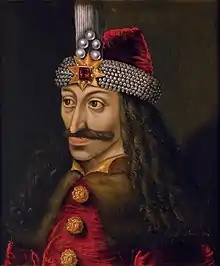Dracula
Dracula is an 1897 Gothic horror novel by Irish author Bram Stoker. It introduced the character of Count Dracula and established many conventions of subsequent vampire fantasy.[1] The novel tells the story of Dracula's attempt to move from Transylvania to England so that he may find new blood and spread the undead curse, and of the battle between Dracula and a small group of people led by Professor Abraham Van Helsing.
.jpg.webp) The cover of the first edition | |
| Author | Bram Stoker |
|---|---|
| Country | United Kingdom |
| Language | English |
| Genre | Horror, Gothic |
| Publisher | Archibald Constable and Company (UK) |
Publication date | 26 May 1897 |
| Pages | 418 |
| OCLC | 1447002 |
Dracula has been assigned to many literary genres including vampire literature, horror fiction, gothic fiction, and invasion literature. The novel has spawned numerous theatrical, film, and television interpretations.
Plot

Dracula is an epistolary novel, told through letters, diary entries, newspaper articles, telegrams, and a ship's log. The novel is set mostly in Transylvania and England, and unfolds mostly chronologically between 3 May and 6 November.
Jonathan Harker, a newly qualified English solicitor, visits Count Dracula at his castle in the Carpathian Mountains to help the Count purchase a house near London. Ignoring the Count's warning, Harker wanders the castle and encounters three vampire women; Dracula rescues him, and Harker realises that he is a vampire, too. Soon after, Dracula leaves the castle, abandoning Harker to the women; Harker escapes with his life and ends up delirious in a Budapest hospital. Dracula takes a ship for England, with boxes of earth from his castle. The captain's log narrates the crew's disappearance, until he alone remains, bound to the helm to maintain course. An animal resembling a large dog is seen leaping ashore when the ship runs aground at Whitby.
Lucy Westenra's letter to her best friend, Harker's fiancée Mina Murray, describes her marriage proposals from Dr. John Seward, Quincey Morris, and Arthur Holmwood. Lucy accepts Holmwood's, but all remain friends. Mina joins her friend Lucy on holiday in Whitby. Lucy begins sleepwalking. After his ship lands there, Dracula stalks Lucy. Mina receives a letter about her missing fiancé's illness, and goes to Budapest to nurse him. Lucy becomes very ill. Seward's old teacher, Professor Abraham Van Helsing, determines the nature of Lucy's condition, but refuses to disclose it. He diagnoses her with acute blood-loss. Van Helsing places garlic flowers around her room and makes her a necklace of them.
Lucy's mother removes the garlic flowers, not knowing they repel vampires. While Seward and Van Helsing are absent, Lucy and her mother are terrified by a wolf and Mrs. Westenra dies of a heart attack. Lucy dies shortly thereafter. After her burial, newspapers report children being stalked in the night by a beautiful lady, and Van Helsing deduces it is her. The four go to her tomb and see that she is a vampire. They stake her heart, behead her, and fill her mouth with garlic. Jonathan Harker and his now-wife Mina have returned, and they join the campaign against Dracula.
Everyone stays at Dr. Seward's asylum as the men begin to hunt Dracula. Van Helsing finally shares what he knows about Dracula and vampires, so all will better understand Dracula's actions and predict his movements. Vampires can only rest on earth from their homeland. Dracula communicates with Seward's patient, Renfield, an insane man who eats vermin to absorb their life force. After Dracula learns of the group's plot against him, he uses Renfield to enter the asylum. He secretly attacks Mina three times, drinking her blood each time and forcing Mina to drink his blood on the final visit. She is cursed to become a vampire after her death unless Dracula is killed.
As the men find Dracula's properties, they also discover many earth boxes within. The vampire hunters open each of the boxes and seal wafers of the host inside them; the sacrament makes the boxes useless to Dracula. They attempt to trap Dracula in his Piccadilly house, but he escapes. They learn that Dracula is fleeing to his castle in Transylvania with his last box. Mina has a faint psychic connection to Dracula, which Van Helsing exploits via hypnosis to track Dracula's movements. Guided by Mina, they pursue him.
In Galatz, Romania, the hunters split up. Van Helsing and Mina go to Dracula's castle, where the professor destroys the vampire women. Jonathan Harker and Arthur Holmwood follow Dracula's boat on the river, while Quincey Morris and John Seward parallel them on land. After Dracula's box is finally loaded onto a wagon by Szgany men, the hunters converge and attack it. After routing the Szgany, Harker slashes Dracula's neck and Quincey stabs him in the heart. Dracula crumbles to dust, freeing Mina from her vampiric curse, and Quincey dies from his wounds. A note by Jonathan Harker seven years later states that the Harkers have a son, named Quincey.
Background
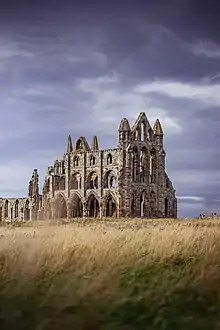
Between 1879 and 1898, Stoker was a business manager for the Lyceum Theatre in London, where he supplemented his income by writing many sensational novels, his most successful being the vampire tale Dracula published on 26 May 1897.[3]:269 Parts of it are set around the English town of Whitby on the Yorkshire coast where he spent summer holidays.[4]
Throughout the 1880s and 1890s, authors such as H. Rider Haggard, Rudyard Kipling, Robert Louis Stevenson, Arthur Conan Doyle, and H. G. Wells wrote many tales in which fantastic creatures threatened to destroy life on Earth. Invasion literature was at a peak, and Stoker's formula was very familiar by 1897 to readers of fantastic adventure stories. Victorian readers enjoyed Dracula as a good adventure story like many others, but it did not reach its legendary status until later in the 20th century when film versions began to appear.[5]
Before writing Dracula, Stoker spent seven years researching European folklore and stories of vampires, being most influenced by Emily Gerard's 1885 essay "Transylvania Superstitions" which includes content about a vampire myth.[6][7] The reputation for cruelty of the Romanian ruler of Wallachia Vlad III Dracula, which Stoker first learned about in 1881,[8] inspired the name of the count Dracula. However, Dracula's scholar Elizabeth Miller has remarked that aside from the name and some mention of Romanian history, the background of Stoker's Count bears no resemblance to that of Vlad III Dracula.[9] From 1890 to 1897 Stoker was a member of the London Library, where markings in Sabine Baring-Gould's “Book of Were-Wolves”, Thomas Browne's “Pseudodoxica Epidemica”, AF Crosse's “Round About the Carpathians” and Charles Boner's “Transylvania” are attributed to Stoker's research for Dracula.[10] Also some 1896 New York World clippings about Mercy Brown were found amongst Stoker's papers, but it is unsure how much the case could have influenced the novel.[11] Later he also claimed that he had a nightmare, caused by eating too much crab meat, about a "vampire king" rising from his grave.[12]
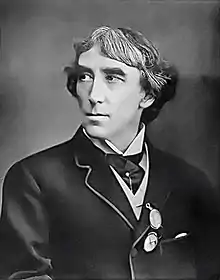
The Lyceum Theatre in the West End where Stoker worked between 1878 and 1898 was headed by actor-manager Henry Irving, who was Stoker's real-life inspiration for Dracula's mannerisms and who Stoker hoped would play Dracula in a stage version.[13] Irving never did agree to do a stage version, but Dracula's dramatic sweeping gestures and gentlemanly mannerisms drew their living embodiment from Irving.[13]
The Dead Un-Dead was one of Stoker's original titles for Dracula, and the manuscript was entitled simply The Un-Dead up until a few weeks before publication. Stoker's notes for Dracula show that the name of the count was originally "Count Wampyr", but Stoker became intrigued by the name "Dracula" while doing research, after reading William Wilkinson's book An Account of the Principalities of Wallachia and Moldavia with Political Observations Relative to Them (London 1820),[14] which he found in the Whitby Library and consulted a number of times during visits to Whitby in the 1890s.[15] The name Dracula was the patronym (Drăculea) of the descendants of Vlad II of Wallachia, who took the name "Dracul" after being invested in the Order of the Dragon in 1431. In the Old Romanian language, the word dracul (Romanian drac "dragon" + -ul "the") meant "the dragon" and Dracula meant "son of the dragon". In the present day however, dracul means "the devil".[16][17]
Publication
Dracula was published in London in May 1897 by Archibald Constable and Company. Costing six shillings, the novel was bound in yellow cloth and titled in red letters.[18] It was copyrighted in the United States in 1899 with the publication by Doubleday & McClure of New York.[19] But when Universal Studios purchased the rights, it came to light that Bram Stoker had not complied with a portion of US copyright law, placing the novel into the public domain.[20] In the United Kingdom and other countries following the Berne Convention on copyrights, the novel was under copyright until April 1962, fifty years after Stoker's death.[21]
Reaction and scholarly criticism
Reaction
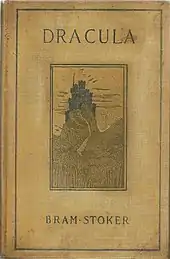
Dracula was not an immediate bestseller when it was first published, although reviewers praised it. Some Victorian fans described it as "the sensation of the season" and "the most blood-curdling novel of the paralysed century".[22] Sherlock Holmes author Arthur Conan Doyle wrote to Stoker in a letter, "I write to tell you how very much I have enjoyed reading Dracula. I think it is the very best story of diablerie which I have read for many years."[23]
According to literary historians Nina Auerbach and David J. Skal in the Norton Critical Edition, the novel has become more significant for modern readers than it was for Victorian readers, most of whom enjoyed it just as a adventure story. It reached its broad and iconic status only later in the 20th century when the movie versions appeared.[24] A. Asbjørn Jøn has also noted that Dracula has had a significant impact on the image of the vampire in popular culture, folklore, and legend.[25][26]
It did not make much money for Stoker. In the last year of his life, he was so poor that he had to petition for a compassionate grant from the Royal Literary Fund,[27] and his widow was forced to sell his notes and outlines of the novel at a Sotheby's auction in 1913, where they were purchased for a little over £2 (equivalent to UK£198 in 2019).[28] But then F. W. Murnau's unauthorized adaptation of the story was released in theatres in 1922 in the form of Nosferatu. Stoker's widow took affront and, during the legal battle that followed, the novel's popularity started to grow.[29] Nosferatu was followed by a successful stage adaptation, touring the UK for three years before arriving in the US where Stoker's creation caught Hollywood's attention and, after the American 1931 movie version was released, the book has never been out of print.[30]
Historical and geographical references
Attention was drawn to the supposed connections between the historical Transylvanian-born Vlad III Dracula (also known as Vlad Tepes) of Wallachia and Bram Stoker's fictional Dracula, following the publication of In Search of Dracula by Radu Florescu and Raymond T. McNally in 1972.[31]
During his main reign (1456–1462), "Vlad the Impaler" is said to have killed from 40,000 to 100,000 European civilians (political rivals, criminals, and anyone that he considered "useless to humanity"), mainly by impaling. The sources depicting these events are records by Saxon settlers in neighbouring Transylvania who had frequent clashes with Vlad III. Vlad III is revered as a folk hero by Romanians for driving off the invading Ottoman Turks, of whom his impaled victims are said to have included as many as 100,000.[32] There is no solid evidence that the Count in the novel was modelled on Vlad the Impaler of Wallachia.[33] At most, Stoker borrowed only the name Dracula and "scraps of miscellaneous information" about Romanian history, according to one expert, Elizabeth Miller; as well, and there are no comments about him in the author's working notes.[34][35]
Historically, the name "Dracula" is derived from a order of chivalry called the Order of the Dragon, founded by Sigismund of Luxembourg (then king of Hungary) to uphold Christianity and defend the Holy Roman Empire against the Ottoman Turks. Vlad II Dracul, father of Vlad III, was admitted to the order around 1431, after which Vlad II wore the emblem of the order and later, as ruler of Wallachia, his coinage bore the dragon symbol, from which the name "Dracula" is derived since "dracul" in Romanian means "the dragon".[36]
Many of Stoker's biographers and literary critics have found strong similarities to the earlier Irish writer Sheridan Le Fanu's classic of the vampire genre Carmilla. In writing Dracula, Stoker may also have drawn on stories about the sídhe,[37] some of which feature blood-drinking women. The Irish legend of Abhartach has also been suggested as a source.[38] It is also thought probable that his mother's stories of events during the severe cholera outbreak in Sligo in 1832 were influential, particularly themes of being buried while alive.[39]
In her book The Essential Dracula, Clare Haword-Maden suggested that the castle of Count Dracula was inspired by Slains Castle, at which Bram Stoker was a guest of the 19th Earl of Erroll.[40] According to Miller, he first visited Cruden Bay in 1893, three years after work had begun on Dracula. Haining and Tremaine maintain that, during this visit, Stoker was especially impressed by Slains Castle's interior and the surrounding landscape. Miller and Leatherdale question the stringency of this connection.[41]
Possibly, Stoker was not inspired by a real edifice at all, but by Jules Verne's novel The Carpathian Castle (1892) or Ann Radcliffe's The Mysteries of Udolpho (1794).[42] A third possibility is that he copied information about Kemény Castle at Vécs from one of his sources on Transylvania, the book by Major E.C. Johnson.[43] A further option is that Stoker saw an illustration of Castle Bran (Törzburg) in the book on Transylvania by Charles Boner, or read about it in the books by Mazuchelli or Crosse.[44]
Many of the scenes in Whitby and London are based on real places that Stoker frequently visited, although he distorts the geography for the sake of the story in some cases. One scholar has suggested that Stoker chose Whitby as the site of Dracula's first appearance in England because of the Synod of Whitby, given the novel's preoccupation with timekeeping and calendar disputes.[45]
Official derivative publications
"Dracula's Guest"
.jpg.webp)
The short story "Dracula's Guest" was posthumously published in 1914, two years after Stoker's death. It was, according to most contemporary critics, the deleted first (or second) chapter from the original manuscript[46] and the one which gave the volume its name,[3]:325 but which the original publishers deemed unnecessary to the overall story.
"Dracula's Guest" follows an unnamed Englishman traveller as he wanders around Munich before leaving for Transylvania. It is Walpurgis Night and the young Englishman foolishly leaves his hotel, in spite of the coachman's warnings, and wanders through a dense forest alone. Along the way, he feels that he is being watched by a tall and thin stranger (possibly Count Dracula).
The short story climaxes in an old graveyard where the Englishman, caught in a blizzard, takes refuge in the marble tomb of "Countess Dolingen of Gratz". Within the tomb, he sees the Countess—apparently asleep and healthy—but before he can investigate further, a mysterious force throws him clear of the tomb. A lightning bolt then strikes the tomb, destroying it and incinerating the undead screaming countess. The Englishman then loses consciousness. He awakens to find a "gigantic" wolf lying on his chest and licking at his throat; however, the wolf merely keeps him warm and protects him until help arrives.
When the Englishman is finally taken back to his hotel, a telegram awaits him from his expectant host Dracula, with a warning about "dangers from snow and wolves and night". The Swedish scholar Rickard Berghorn noted that the description of the blonde countess in Dracula's Guest closely resembled the description of Josephine in the Powers of Darkness, which he used to argue that the countess and Josephine were meant to be the same character.[47]
Powers of Darkness
In 1901, Dracula was translated into Icelandic by Valdimar Ásmundsson under the title Makt Myrkranna (Powers of Darkness) with a preface written by Stoker.[48] Not until 2014 was it noticed that Makt Myrkranna differed significantly from Stoker's version of Dracula.[48] The characters had different names, the book was shorter and there was more emphasis on sex than in the English version.[48] The Dutch scholar Hans Corneel de Roos wrote: "Although Dracula received positive reviews in most newspapers of the day...the original novel can be tedious and meandering....Powers of Darkness, by contrast, is written in a concise, punchy style; each scene adds to the progress of the plot."[48] In Makt Myrkranna, Dracula is in contact with various ambassadors in what is hinted at is a bid for world domination.[49] The majority of Makt Myrkranna concerns Thomas Harker's (as Jonathan Harker is called here) stay at Dracula's castle in Transylvania, with the rest of novel being a rushed and barely fleshed out story.[49]
De Roos has argued that the differences between the English original of Dracula and the Icelandic version were not due to changes made by Ásmundsson, but rather that he was using a different, older manuscript of Dracula provided to him by Stoker, which the latter had discarded for the English version.[48] De Roos has argued that some aspects of Makt Myrkranna were due to Ásmundsson and other aspects were parts of Dracula that Stoker had removed due to concerns about government censorship.[49]
Adaptations
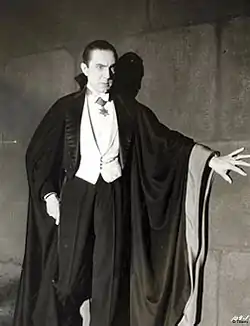
The story of Dracula has been the basis for numerous films and plays. Stoker himself wrote the first theatrical adaptation, which was presented at the Lyceum Theatre on 18 May 1897 under the title Dracula, or The Undead shortly before the novel's publication and performed only once, in order to establish his own copyright for such adaptations. This adaption was first published only a century later in October 1997.[50] The first motion picture to feature Dracula was Dracula's Death, produced in Hungary in 1921.[51] The now-lost film, however, was not an adaptation of Stoker's novel, but featured an original story.[52]
F. W. Murnau's unauthorised film adaptation Nosferatu was released in 1922, and the popularity of the novel increased considerably, owing to an attempt by Stoker's widow to have the film removed from public circulation.[53] Prana Film, the production company, had been unable to obtain permission to adapt the story from Bram's widow Florence Stoker, so screenwriter Henrik Galeen was told to alter numerous details to avoid legal trouble. Galeen transplanted the action of the story from 1890s England to 1830s Germany and reworked several characters, dropping some (such as Lucy and all three of her suitors), and renaming others (Dracula became Orlok, Jonathan Harker became Thomas Hutter, Mina became Ellen, and so on). This attempt failed to avoid a court case, however; Florence Stoker sued Prana Film, and all copies of the film were ordered to be destroyed. However, the company was bankrupt, and Stoker only recovered her legal fees in damages. Some copies survived and found their way into theatres. Eventually, Florence Stoker gave up the fight against public displays of the film.[20] Subsequent rereleases of the film have typically undone some of the changes, such as restoring the original character names (a practice also followed by Werner Herzog in his 1979 remake of Murnau's film Nosferatu the Vampyre).
Florence Stoker licensed the story to playwright Hamilton Deane, whose 1924 stage play adaptation toured England for several years before settling down in London. In 1927, American stage producer Horace Liveright hired John L. Balderston to revise Deane's script in advance of its American premiere. Balderston significantly compressed the story, most notably consolidating or removing several characters. The Deane play and its Balderston revisions introduced an expanded role and history for Renfield, who now replaced Jonathan Harker as Dracula's solicitor in the first part of the story; combined Mina Harker and Lucy Westenra into a single character named Lucy (though both Mina and Lucy would appear in the subsequent film); and omitted both Arthur Holmwood and Quincey Morris entirely. When the play premiered in New York, it was with Bela Lugosi in the title role, and with Edward Van Sloan as Abraham Van Helsing, roles which both actors (as well as Herbert Bunston as Dr. Seward) reprised for the English-language version of the 1931 Universal Pictures film production. The 1931 film was one of the most commercially successful adaptations of the story to date; it and the Deane/Balderston play that preceded it set the standard for film and television adaptations of the story, with the alterations to the novel becoming standard for later adaptations for decades to come. Universal Studios continued to feature the character of Dracula in many of their horror films from the 1930s and 1940s.
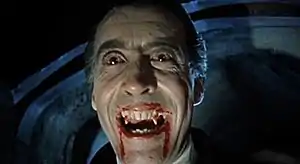
In 1958, film company Hammer Film Productions followed the success of its The Curse of Frankenstein from the previous year with Dracula, released in the United States as Horror of Dracula, directed by Terence Fisher. Fisher's production featured Christopher Lee as Dracula and Peter Cushing as Van Helsing. It was an international hit for Hammer Film, and Lee fixed the image of the fanged vampire in popular culture.[54][55] Both Lee and Cushing reprised their roles multiple times over the next decade and a half, concluding with The Legend of the 7 Golden Vampires (with Cushing but not Lee) in 1974. Christopher Lee also took on the role of Dracula in Count Dracula, a 1970 Spanish-Italian-German co-production notable for its adherence to the plot of the original novel. Playing the part of Renfield in that version was Klaus Kinski, who later played Dracula himself in 1979's Nosferatu the Vampyre.
In 1977, the BBC made Count Dracula, a 155-minute adaptation for television starring Louis Jourdan. Later film adaptations include John Badham's 1979 Dracula, starring Frank Langella and inspired by the 1977 Broadway revival of the Deane/Hamilton play, and Francis Ford Coppola's 1992 Bram Stoker's Dracula, starring Gary Oldman. The character of Count Dracula has remained popular over the years, and many films have used the character as a villain, while others have named him in their titles, including Dracula's Daughter and The Brides of Dracula.
See also
- Vampire literature
- St Mary's Church, Whitby
- List of contemporary epistolary novels
- Bloodline (Cary novel)
- The Book of Renfield: A Gospel of Dracula, a fictional diary written by Renfield
- The Dracula Series, stories from Dracula's point of view written by Fred Saberhagen
- Clinical vampirism
- Bibliography of works on Dracula
References
- "Bram Stoker - Novels". Bramstoker.org. Archived from the original on 10 August 2017.
- "How Dracula Came To Whitby". English Heritage. Archived from the original on 12 January 2021.
- Belford, Barbara (2002). Bram Stoker and the Man Who Was Dracula. ISBN 0-306-81098-0.
- "Abraham Stoker, Jr. A Collection By and About Bram Stoker, Himself". Bram Stoker LLC for Bram Stoker Estate.
- Nina Auerbach and David Skal, editors. (1997). Dracula. Norton Critical Edition. ISBN 0-393-97012-4. Preface, first paragraph.
- "The Land beyond the forest: source material for Dracula". The British Library. Archived from the original on 12 January 2021.
- Davison 1997, p. 142.
- "On this day: Irish "Dracula" author Bram Stoker was born". IrishCentral.com. 8 November 2020. Archived from the original on 12 January 2021.
- Elizabeth Miller. "Romania – My Old Haunts. Dracula: The Metamorphosis of a Fiend. Interview with the Vampire Queen". Frontine/World Pbs.org. Archived from the original on 12 January 2021.
- "Dracula". www.londonlibrary.co.uk. Archived from the original on 12 January 2021.
- "The Great New England Vampire Panic". Smithsonian Magazine. Archived from the original on 12 January 2021.
- Davison 1997, p. 24.
- Lewis S Warren, Buffalo Bill Meets Dracula: William F. Cody, Bram Stoker, and the Frontiers of Racial Decay Archived 6 May 2013 at the Wayback Machine, American Historical Review, Vol. 107, No. 4, October 2002, paragraph 18
- An account of the principalities of Wallachia and Moldavia – William Wilkinson, Longman, 1820 (Google Free eBook)
- Radu R. Florescu and Raymond T. McNally Dracula, Prince of Many Faces. Little Brown. 1989. ISBN 0316286567. pp. 229–31.
- Raymond T. McNally and Radu R. Florescu In Search of Dracula, The History of Dracula and Vampires (Completely Revised). Houghton Mifflin. 1994. ISBN 0-395-65783-0. pp. 8–9.
- Thackeray, Frank W.; Findling, John E. (2012). Events That Formed the Modern World. ABC-CLIO. ISBN 978-1598849011 – via Google Books.
- Davison 1997, p. 19.
- Wood, Margaret (6 February 2013). "Copyright and Dracula". Library of Congress. Library of Congress. Archived from the original on 8 December 2015.
- Stoker, Dacre; Holt, Ian (2009). Dracula The Un-Dead. Penguin Publishing Group. pp. 312–13. ISBN 978-0-525-95129-2.
- Lugosi v. Universal Pictures, 70 Cal.App.3d 552 (1977), note 4.
- Richard Dalby "Bram Stoker", in Jack Sullivan (ed) The Penguin Encyclopedia of Horror and the Supernatural, 1986, Viking, pp. 404–06 [405].
- Klinger, p. xxxii
- Nina Auerbach and David Skal, editors. Dracula. Norton Critical Edition. 1997. ISBN 0-393-97012-4. Preface, first paragraph.
- Jøn, A. Asbjørn (2003). "Vampire Evolution". METAphor (3): 19–23. Archived from the original on 12 January 2021.
- Jøn, A. Asbjørn (2001). "From Nosteratu to Von Carstein: shifts in the portrayal of vampires". Australian Folklore: A Yearly Journal of Folklore Studies. University of New England (16): 97–106. Archived from the original on 25 November 2015.
- "Bram Stoker – Stoker, Irving & Count Vlad". Today in Literature. 20 April 1912. Archived from the original on 12 January 2021.
- "Bram Stoker's "Dracula" by Gothic Candlelight". Irishphiladelphia.com. 10 June 2011. Archived from the original on 12 January 2021.
- "Sympathy for the Vampire: On "Nosferatu"". College Film & Media Studies. 23 April 2014. Archived from the original on 12 January 2021.
- Stoker, Bram. "Cult Vampires – Extract from Dracula by Bram Stoker". BBC.
- "Radu Florescu dead: Legacy of the Romanian 'Dracula professor'". Independent.co.uk. 20 May 2014. Archived from the original on 12 January 2021.
- Andreescu, Stefan (1999). Vlad the Impaler (Dracula). The Romanian Cultural Foundation Publishing House. ISBN 978-9735771973.
- Berni, Simone (2016). Dracula by Bram Stoker The Mystery of The Early Editions. Lulu.com. ISBN 978-1326621797 – via Google Books.
- Jr, Jimmie E. Cain (2006). Bram Stoker and Russophobia: Evidence of the British Fear of Russia in Dracula and The Lady of the Shroud. McFarland. ISBN 978-0786424078. Archived from the original on 12 January 2021 – via Google Books.
- Light, Duncan (2016). The Dracula Dilemma: Tourism, Identity and the State in Romania. Routledge. ISBN 978-1317035312 – via Google Books.
- Ripley, Brian (2013). Dracula. Strategic Book Publishing. ISBN 978-1628570298 – via Google Books.
- Blake, Marc; Bailey, Sara (2013). Writing the Horror Movie. Bloomsbury. p. 12. ISBN 978-1441196187.
- Curran, Bob (Summer 2000). "Was Dracula an Irishman?". History Ireland. 8 (2).
- "The Sligo epidemic that stoked Bram's interest in all things". independent. Archived from the original on 12 January 2021.
- Haword-Maden, Clare. The Essential Dracula. London: Bison Books, 1992
- Haining, Peter and Tremayne, Peter. The Un-Dead: The Legend of Bram Stoker and Dracila. London: Constable 1997, quoted by Miller, Elizabeth. Dracula – Sense & Nonsense, 2nd ed. Westcliff-on-Sea, UK: Desert Island Books, 2006, p. 19. See also Leatherdale, Clive. Dracula Unearthed. Westcliff-on-Sea, UK: Desert Island Books, 1998, p. 13
- Elizabeth Miller, Dracula: Sense & Nonsense. 2nd ed. Westcliff-on-Sea, UK: Desert Island Books, 2006, p. 141
- Major E.C. Johnson, On the Track of the Crescent: Erratic Notes from the Piraeus to Pesth. London: Hurst and Blackett, 1885. pp. 256–257, quoted by Marius Crișan, The Models for Castle Dracula in Stoker's Sources on Transylvania, Journal of Dracula Studies Nr 10 (2008); also referred to by Miller, 2006, p. 141
- Charles Boner, Transylvania: Its Products and Its People. London: Longmans, 1865. Referred to by Marius Crișan, The Models for Castle Dracula in Stoker's Sources on Transylvania, Journal of Dracula Studies Nr 10 (2008). As indicated by Crişan, Crosse's book Round About the Carpathians and Mazuchelli's Magyarland describe Törzburg as well.
- "Killing Time: Dracula and Social Discoordination" in Economics of the Undead Eds. Glen Whitman and James Dow (Rowman & Littlefield, 2014), chapter 23
- Holte, James Craig (1997). Dracula Film Adaptations. p. 27. ISBN 9780313292156.
- Berghorn, Rickard (2017). "Dracula's Way to Sweden". Weird Webzine. Retrieved 2 September 2019.
- Escher, Kat (19 May 2017). "The Icelandic Translation of 'Dracula' Is Actually a Different Book". Smithsonian. Archived from the original on 15 December 2019.
- Melgaard, Michael (13 March 2017). "Counted out: An alternative version of Dracula with an obscure preface appears over a century later". The National Post. Archived from the original on 12 January 2021.
- Stoker, Bram, (1997). Dracula: or The Undead – A Play in Prologue and Five Acts, Ed. Sylvia Starshine, Pumpkin Books, Nottingham. ISBN 1901914046
- "Silent Era : Progressive Silent Film List". www.silentera.com. Archived from the original on 12 January 2021.
- Bills, E.R. (2017). Texas Far & Wide: The Tornado with Eyes, Gettysburg's Last Casualty, the Celestial Skipping Stone & Other Tales. History Press Library Editions. p. 66. ISBN 978-1540227089. Retrieved 11 July 2019.
- Stoker, Bram. "Article at the BBC Cult website". BBC. Retrieved 17 May 2014.
- J Gordon Melton (2010). "The Vampire Book: The Encyclopedia of the Undead". p. 247. Visible Ink Press
- "Fangs for the memories: The A–Z of vampires". The Independent (31 October 2009). Archived from the original on 4 January 2018.
Bibliography
- Davison, Carol Margaret (1997). Bram Stoker's Dracula: Sucking Through the Century, 1897–1997. Toronto, Ontario: Dundurn. ISBN 9781554881055.
- Dalby, Richard and Hughes, William. Bram Stoker: A Bibliography (Westcliff-on-Sea: Desert Island Books, 2005)
- Frayling, Christopher. Vampyres: Lord Byron to Count Dracula (1992) ISBN 0-571-16792-6
- Eighteen-Bisang, Robert and Miller, Elizabeth. Bram Stoker's Notes for Dracula: A Facsimile Edition Toronto: McFarland, 2008, ISBN 978-0-7864-3410-7
- Hughes, William. Beyond Dracula: Bram Stoker's Fiction and its Cultural Contexts (Basingstoke: Macmillan, 2000)
- McNally, Raymond T. & Florescu, Radu. In Search of Dracula. Houghton Mifflin Company, 1994. ISBN 0-395-65783-0
- Miller, Elizabeth. Dracula: Sense & Nonsense. 2nd ed. Desert Island Books, 2006. ISBN 1-905328-15-X
- Schaffer, Talia. A Wilde Desire Took Me: the Homoerotic History of Dracula, in: ELH – Volume 61, Number 2 (1994), pp. 381–425.
- Senf, Carol. Science and Social Science in Bram Stoker's Fiction (Greenwood, 2002).
- Senf, Carol. Dracula: Between Tradition and Modernism (Twayne, 1998).
- Spencer, Kathleen. Purity and Danger: Dracula, the Urban Gothic, and the Late Victorian Degeneracy Crisis, in: ELH – Volume 59, Number 1 (1992), pp. 197–225.
- Wolf, Leonard. The Essential Dracula. ibooks, inc., 2004. ISBN 0-7434-9803-8
- Klinger, Leslie S. The New Annotated Dracula. W.W. Norton & Co., 2008. ISBN 0-393-06450-6
- Waters, Colin Gothic Whitby. History Press, 2009 – ISBN 0-7524-5291-6
External links
| Wikisource has original text related to this article: |
- Dracula at Standard Ebooks
- Dracula at Project Gutenberg, text version of 1897 edition.
 Dracula public domain audiobook at LibriVox
Dracula public domain audiobook at LibriVox- Bram Stoker, Dracula and Whitby BBC article
- The Myth of Transylvania, Romanian Website dealing with the Dracula myth and the Western perception of Romania.
- Journal of Dracula Studies
- Links between Dracula, Bram Stoker and the Yorkshire town of Whitby
